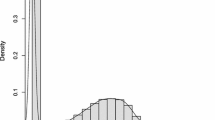Abstract
Undiscovered oil and gas assessments are commonly reported as aggregate estimates of hydrocarbon volumes. Potential commercial value and discovery costs are, however, determined by accumulation size, so engineers, economists, decision makers, and sometimes policy analysts are most interested in projected discovery sizes. The lognormal and Pareto distributions have been used to model exploration target sizes. This note contrasts the outcomes of applying these alternative distributions to the play level assessments of the U.S. Geological Survey's 1995 National Oil and Gas Assessment. Using the same numbers of undiscovered accumulations and the same minimum, medium, and maximum size estimates, substitution of the shifted truncated lognormal distribution for the shifted truncated Pareto distribution reduced assessed undiscovered oil by 16% and gas by 15%. Nearly all of the volume differences resulted because the lognormal had fewer larger fields relative to the Pareto. The lognormal also resulted in a smaller number of small fields relative to the Pareto. For the Permian Basin case study presented here, reserve addition costs were 20% higher with the lognormal size assumption.
Similar content being viewed by others
REFERENCES
Attanasi, E. D., 1998, Economics and the 1995 National Assessment of United States Oil and Gas Resources: U.S. Geol. Surv. Cir., v. 1145, 35 p.
Drew, L. J., and Schuenemeyer, J. H., 1993, Evolution and use of discovery process models at the U.S. Geological Survey: Am. Assoc. Pet. Geol. Bull., v. 77, no. 3, p. 467–478.
Gautier, D. L., and Dolton, G. L., 1996, Methodology for assessment of undiscovered conventional accumulations, in Gautier, D. L., Dolton, G. L., Takahashi, K. I., and Varnes, K. L., eds., 1995 National Assessment of United States Oil and Gas Resources on CD-ROM: U.S. Geol. Survey Digital Data Series 30, release 2, one CD-ROM.
Houghton, J. C., 1988, Use of the truncated shifted Pareto distribution in assessing size distribution of oil and gas fields: Math. Geol., v. 20, no. 8, p. 907–937.
Houghton, J. C., Dolton, G. L., Mast, R. F., Masters, C. D., and Root, D. H., 1993, U.S. Geological Survey estimation procedure for accumulation size distribution by play: Am. Assoc. Pet. Geol. Bull., v. 77, no. 3, p. 454–466.
Johnson, N. L., and Kotz, S., 1970, Continuous univariate distributions-1: Houghton-Mifflin, Boston, MA, 300 p.
Kaufman, G. M., 1993, Statistical issues in the assessment of undiscovered oil and gas resources: Energy J., v. 14, no. 1, p. 183–215.
Rose, P. R., 1994, Chance of success and its use in petroleum exploration, in Steinmetz, R., ed., The business of petroleum exploration: Tulsa, Am. Assoc. Pet. Geol., p. 71–85.
Schuenemeyer, J. H., and Drew, L. J., 1983, A procedure to estimate the parent population of the size of oil and gas fields as revealed by a study of economic truncation: Math. Geol., v. 15, no. 1, p. 145–161.
United States Geological Survey, National Oil and Gas Resource Assessment Team, 1995, 1995 National Assessment of United States Oil and Gas Resources: U.S. Geol. Surv. Cir. v. 1118, 20 p.
Author information
Authors and Affiliations
Rights and permissions
About this article
Cite this article
Attanasi, E.D., Charpentier, R.R. Comparison of Two Probability Distributions Used to Model Sizes of Undiscovered Oil and Gas Accumulations: Does the Tail Wag the Assessment?. Mathematical Geology 34, 767–777 (2002). https://doi.org/10.1023/A:1019809410934
Issue Date:
DOI: https://doi.org/10.1023/A:1019809410934




